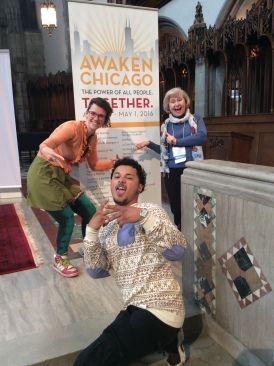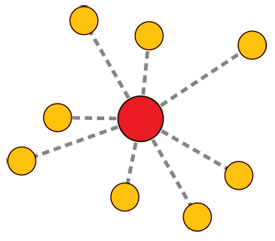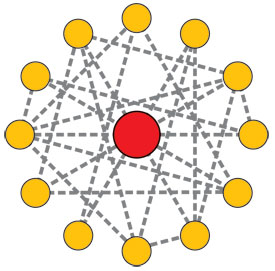 “Stillness is our friend.”
“Stillness is our friend.”
Phil Porter was the first to say it in InterPlay. He saw stillness create clarity in the process of performing movement. Meanwhile, most of us other movers and shakers let him have his way as we worked on it.
As time went on many of us realized that stillness is more than a skill. It’s a gateway for deep witnessing. It offers us an unconditional creative home in oneself where nothing is required, yet many things can happen. It is a route to peace in community practice.
This is why stillness is one of the five freedoms we teach: freedom of movement, voice, speech, stillness, and connection. In InterPlay today you are likely to enter stillness and silence through movement, voice, and telling stories. In cases where a meditation teacher is leading, you may find yourself moving from sitting practices into new areas of embodied play, joy, and freedom through InterPlay practices.
Cynthia Winton-Henry, one of the founders of InterPlay has offered a weekly InterPlay meditative movement practice at InterPlayce in Oakland, California since 2004. This practice includes a gentle warm up accompanied by music that guides people to move and listen to the wisdom of their body in their movement, stillness, breath and voice. This may last from 10-20 minutes. After this other forms are introduced that focus on and encourage us to claim our body wisdom in life. The session concludes with a brief time for noticing and reflection.
A favorite form in InterPlay is Shape and Stillness. This practice invites people to move from shape to shape with as much as 80 percent stillness. This allows movers to listen their own body and be attentive to those around us. Inevitably, the awareness of interconnection and beauty arise. This is one of InterPlays most successful and inclusive forms because as Eckhardt Tolle writes in the Power of Now, “To meet everything and everyone in stillness instead of mental noise is the greatest gift you can offer to the universe. I call it stillness, but it is a jewel with many facets: that stillness is also joy, and it is love.”

InterPlay’s Mindful/Bodyful Qualities
InterPlay brings a unique focus to personal and group practice by welcoming the wisdom of the body and reintroducing the ability to playfully create in meaningful ways and learn as we go. Creativity show us that we are more than our suffering. We are alive and resourceful! Nor is artfulness dependant on special ability. It is native to all people. All one needs is willingness. Tap into this creative source and everyone is enriched. The InterPlay forms are so invitingly possible most people cannot resist this invitation once they are in the room.
Another basic InterPlay practice is to notice, usually after an activity. Noticing heightens our ability to pay attention to whatever is present. It could be big or little. Even if we can’t articulate it, that’s just fine. Noticing is different from judging. Noticing builds up an appreciative respect for our body data, the bits and pieces of experience including thoughts, feelings, memories, etc. We also notice our body knowledge, those patterns in us that we experience over time, and gratefully, our ability to choose at any given moment what we want for our own good and the good of others. We call that our body wisdom.
We use easy focus to help us lighten our focus. Instead of grasping or analyzing things that come to our attention, we invite our vision and body into spaciousness so that we can be present to the whole of experience.
We willingly enter and investigate the improvisatory spirit of whatever is moving in and through us. As we honor experience as temporary yet meaningful we learn to savor life, let go and then open to the next new thing.The more we let go and play with each new thing the less we seem to resist our life experiences.
We honor the speed of the body. With such a great need for stillness and rest in personal and social health, slowing down, being present and finding ourselves in direct contact with the earth, immediacy of breath, thought, energy, imagination, each other, joy, sorrow and life is potent and worth it. In this our body is our greatest teacher!
InterPlay Mindfulness and Meditation Teachers
Wonderful teachers are exploring and teaching at the intersection of InterPlay and meditation. Trained to share InterPlay’s eight body wisdom tools and simple structured practices they support people to find and claim a vital nature that is responsive and true.
Kaira Jewel Lingo, a widely traveled dharma teacher shares her inspiring journey into creative mindfulness and bodyfulness and says,
inspiring journey into creative mindfulness and bodyfulness and says,
I bring InterPlay into my teaching and practice of mindfulness every chance I get. On retreats or days of mindfulness or when I share mindfulness with kids in schools, it always refreshes and inspires and I see a light in people’s eyes and a bounce in their step that wasn’t there before. They are more connected to each other and to themselves and they can see life in a new and more hopeful way. There is always laughter and a sense of discovery and curiosity. It is healing in the best of ways, because it is subtle, unassuming and has no agenda except to create fun and joy. I am so grateful for the many precious moments of meaning and transformation it has brought to my life and that of so many others with whom I have shared it!
Read her honest and compelling tale here.
 In the Seattle Insight Meditation Society Quarterly Newsletter Anne Trench writes about teacher Krista Harris, “Krista wants us to “come out and play” in SanghaPlay… What is that all about? we might ask. Krista, a trained facilitator in the InterPlay movement, has adapted concepts from InterPlay to help us explore Buddhist principles.”
In the Seattle Insight Meditation Society Quarterly Newsletter Anne Trench writes about teacher Krista Harris, “Krista wants us to “come out and play” in SanghaPlay… What is that all about? we might ask. Krista, a trained facilitator in the InterPlay movement, has adapted concepts from InterPlay to help us explore Buddhist principles.”
In 2000, an incredibly vital InterPlay friend of Krista’s was diagnosed with incurable cancer. Krista pledged to create a space with fellow InterPlayers where Peggy “could dance and sing, and tell big stories about her journey with cancer.” Seeking to better understand all that was happening, Krista stumbled on a course entitled “A Year to Live,” given by Rodney Smith. During that hard year and in the years that followed, Krista discovered many similarities and complementary connections between InterPlay and meditation. The basic, well-known forms of InterPlay helped Peggy embrace death, just as the basic, known practices of meditation – being still, focusing on the breath, being with what is – were helping Krista more fully embrace life. For over ten years, Krista has been working to deepen the embodied knowledge of stillness in the InterPlay community, and she wants to bring more embodied knowledge of “play” to the SIMS sangha. Read more here.
AJ Johnston introduced InterPlay to her sangha in Missoula, as well as on the Eastern

Shore of Virginia, and in Berkeley. Read what people discovered here including Ria de Neeve who said,”I have touched places in my Mindfulness Practice, like Joy and Freedom, that I couldn’t access on the cushion.”
 Susan Pudelek is an ambassador of the Parliament World Religions and part of an ongoing Catholic Buddhist dialogue. At Awaken Chicago, hosted by the Chicago Shambala community she and Agnotti Cowie, InterPlay Millennial Liaison, led InterPlay and Deep Listening with outstanding response. The purpose was to address Chicago’s “deep roots of isolation, inequality and violence that touch every one of our lives. The power is within all of us, individually and collectively, to transform these roots with open-hearted bravery and challenge a new paradigm to emerge, grow, and flourish. That is what Awaken Chicago is all about – a weekend to be together, listen and search within ourselves for the bravery, acceptance, and compassion desired to make this historic shift.” In storytelling these leaders supported a kind of joyful witnessing where people connect story to story. 71 people did small practices like “I could talk about,” 30 seconds of telling, and much more.
Susan Pudelek is an ambassador of the Parliament World Religions and part of an ongoing Catholic Buddhist dialogue. At Awaken Chicago, hosted by the Chicago Shambala community she and Agnotti Cowie, InterPlay Millennial Liaison, led InterPlay and Deep Listening with outstanding response. The purpose was to address Chicago’s “deep roots of isolation, inequality and violence that touch every one of our lives. The power is within all of us, individually and collectively, to transform these roots with open-hearted bravery and challenge a new paradigm to emerge, grow, and flourish. That is what Awaken Chicago is all about – a weekend to be together, listen and search within ourselves for the bravery, acceptance, and compassion desired to make this historic shift.” In storytelling these leaders supported a kind of joyful witnessing where people connect story to story. 71 people did small practices like “I could talk about,” 30 seconds of telling, and much more.

InterPlayers have much to learn from these and leaders like Chinh Nyugen, Connors McConville, therapist and spiritual director, Wakoh Shannon Hickey, Professor of Religious Studies and Zen Buddhist Priest, and Kelsey Blackwell at Shamhala Meditation Community in Oakland. They exemplify what Spirit Rock teacher Wes Nisker says,
“In order to hear crazy wisdom, we need to somehow shut off or turn down the grinding noise of the rational, analytic gears. Crazy wisdom requires that we get at least a little bit out of our minds.”
What better way than to dance, sing, take a deep breath, and hear a good story? Yours, mine or ours!
InterPlay plays well with other practices, mindsets, and disciplines to help to bring the whole body into play with best practices.







 Posted by Cynthia Winton-Henry
Posted by Cynthia Winton-Henry  is good and the other is suspect. (And you and I know which one is which.)
is good and the other is suspect. (And you and I know which one is which.)

 by Phil Porter
by Phil Porter




